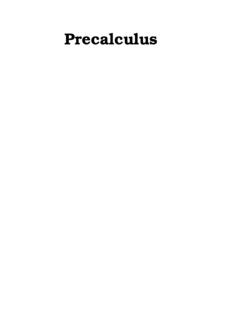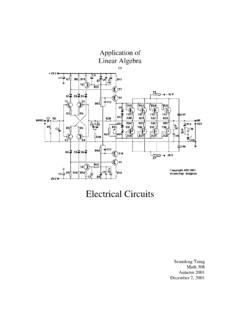Transcription of Taylor Polynomials and Taylor Series
1 Taylor Polynomials and Taylor SeriesMath 126In many problems in science and engineering we have a functionf(x) which is toocomplicated to answer the questions we d like to ask. In thischapter, we will use localinformation near a pointx=bto find a simpler functiong(x), and answer the questionsusingginstead off. How useful the answers will be depends upon how closely the functiongapproximatesf, so we also need to estimate, or bound, the error in this approximation:f g. 1. Tangent Line Error is at work and his car is located at his home twenty miles north. Fifteen minutesfrom now, in the absence of any other information, his best guess is that the car is still athome. How accurate is this guess?
2 If Ken knows his son will drive the car no faster than40 miles per hour in the city, how far away can the car be in 15 minutes? A moment sreflection should give you the estimate (or bound) that his son can drive the car no furtherthan 10 miles (14hour at 40 mph) so that the car will be within 10 miles of home, or nomore than 30 miles from Ken. We can also see this by using the Fundamental Theorem ofCalculus. Suppose Ken s son is driving the car in a straight line headed north and supposex(t) is the distance of the car from Ken at timetthenx(t) x(0) = t0x (u) (u) is the velocity at timeu. In this problem we know|x (u)| 40 for allubetween0 andt, so that|x(t) x(0)|= t0x (u)du t0|x (u)|du( ) t040du= are a couple of steps above that need justification.
3 First we used the inequality x (u)du |x (u)| integral x (u)durepresents the area which is below the curvey=x (u) and abovetheu-axis minus the area which is above the curve and below theuaxis. Whereas theright-hand side is equal to the total area between the curve and theuaxis, and so theright-hand side is at least as big as the left. Secondly we replaced the function|x (u)|bythe larger constant 40 and the area under the curvey= 40 is at least as big as the areaunder the curvey=|x (u)|.This was a rather long-winded way to get the same bound, but itworks in general: if|f (t)| Mfor alltbetweenbandx, then|f(x) f(b)| M|x b|.Test your understanding by writing out the reasoning behindthis we have more information, then we can get a better approximation.
4 For example,suppose Ken s wife called and said that their son left home driving north at 30 miles perhour. Then we might guess that after 15 minutes he is 30/4 or miles north of Ken shome. Here we ve used the tangent line approximationx(t) x(0) x (0)(t 0).Recall that the equation of the line which is tangent to the graph ofy=f(x), whenx=b, passes through the point (b, f(b)) and has slopef (b). The equation of the tangentline is then:y f(b) =f (b)(x b)ory=f(b) +f (b)(x b),which we will call thetangent line approximation, or sometimes thefirst Taylorpolynomialforfbased atb(bfor based ).2(b, f(b))xyy=f(x)Figure line through (b, f(b))In Chapter 3 of Stewart, we found that the tangent line was useful for approximatingcomplicated functions: the graph of the linear functiony=f(b) +f (b)(x b) is close tothe graph ofy=f(x) ifxis nearb.
5 In other wordsf(x) =f(b) +f (b)(x b) + big is the error?errorbxyy=f(b) +f (b)(x b)y=f(x)Figure in tangent line Line Error |f (t)| Mfor alltbetweenxandbthen|error|= f(x) [f(b) +f (b)(x b)] M2|x b| terms of the previous example, if we know that Ken s son starts with a speed of30 mph and accelerates no more that 20mi/hr2while driving away, then at timetwe canestimate his location asx(t) x(0) +x (0)tand the error in this approximation can be bounded by the Tangent Line Error Bound: x(t) [x(0) +x (0)t] 202t2.( )3In particular, after 15 minutes, the error x(14) [20 + 30 14] is at most202(14)2=58miles. Check the details to be sure you question we could ask is: how long will it take Ken s son to be 25 miles fromKen?
6 Replace the complicated (and unknown) functionx(t) with the linear approximationy=x(0) +x (0)tto answer the question:25 =|x(0) +x (0)t|=|20 + 30t|,sot= 1/6, or 10 minutes would be the approximate more difficult question is: when can Ken be sure his son is at least 25 miles fromKen? To answer this question, we write the error bound ( ) in a different form: 10t2 x(t) (20 + 30t) 20 + 30tto the left hand inequality we obtain20 + 30t 10t2 x(t).So to guarantee 25 x(t), it is sufficient to have25 20 + 30t 10t2,or at least (3 7)/2 hours, which is about 11 minutes. (It might take this long ifhe is decelerating because we really assumed that theabsolute valueof the acceleration wasat most 20.)
7 Why is theTangent Line Error Boundtrue? Supposex > bthen by the Funda-mental Theorem of Calculusf(x) f(b) = xbf (t) a constant for the moment and setU=f (t),V=t xand integrate by partsto obtainf(x) f(b) =f (t)(t x) xb xb(t x)f (t)dt( )=f (b)(x b) + xbf (t)(x t) (b)(x b) from both sides we obtain f(x) [f(b) +f (b)(x b)] xb|f (t)|(x t)dt xbM(x t)dt=M2(x b) we used the same ideas as the inequalites in ( ) and thefact thatx t case whenx < bis proved similarly. You might test your understanding of theabove argument by writing out a proof for that Find a bound for the error in approximating the functionf(x) = tan 1(x)by the first Taylor polynomial (tangent line approximation)based atb= 1 on the intervalI= [.]
8 9, ].The first step is to find the tangent line approximation based at 1:y= 4+12(x 1).Then calculate the second derivative:f (x) = 2x(1 +x2)2and forxin the intervalI,|f (x)|=2x(1 +x2) computing a derivative, you can show that|f (x)|is decreasing on the intervalIsothat its maximum value onIis equal to its value atx= , and|f (x)| 2( )(1 + )2 , the Tangent Line Error Bound gives tan 1(x) [ 4+12(x 4)] (x 1)2 other words, if we use the simple functiony= 4+12(x 1) instead of the morecomplicated tan 1(x), we will make an error in the values of the function of no whenxis in the the same functionf(x) = tan 1(x), find an intervalJso that theerror is at intervalJwill be smaller than the intervalI, <.
9 0028, so the samebound holds forxinJ: tan 1(x) [ 4+12(x 4)] (x 1) error will be at most (x 1)2 |x 1|< . if we setJ= [.94, ] then the error is at most whenxis word of caution: we rarely can tell exactly how big the the Tangent Line error is,that is, the exact difference between the function and its first Taylor polynomial. The pointof the Tangent Line Error Bound is to give some control or bound on how big the errorcan be. Sometimes we cannot tell exactly how big|f (t)|is, but many times we can say itis no more than some numberM. Smaller numbersMof course give better (or smaller)bounds for the error. In Example , we found the maximum of the second derivative onthe larger intervalI.
10 There is actually a better (smaller) bound on the smaller intervalJ,but that bound would have been hard to find before we even knew whatJis!6 2. Quadratic ApproximationIn many situations, the tangent line approximation is not good enough. For example,ifh(t) is the height of baseball thrown into the air, thenh(t) is influenced by its initialpositionh(0), initial vertical velocityh (0) and vertical accelerationh = gdue to simple model for theh(t) can be found by integration:h(t) h(0) +h (0)t g2t2.( )However, there are other forces on the baseball, for exampleair resistance is right-hand side of ( ) is called a quadratic approximation to the functionh. Howdo we find a quadratic approximation to a functiony=f(x) and how accurate is thisapproximation?

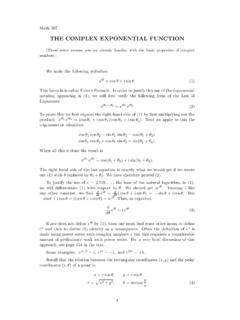

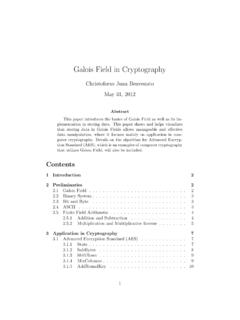

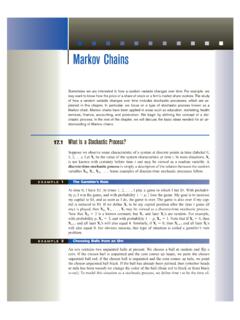
![ZZ dA R [0 2] R - University of Washington](/cache/preview/6/4/c/c/9/f/d/6/thumb-64cc9fd6ac93e2995c04a2a74b217176.jpg)
